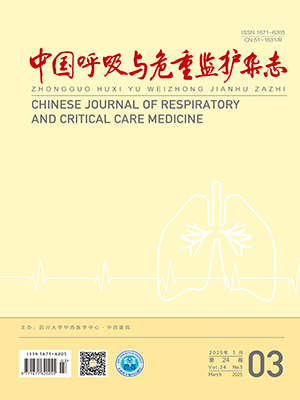Objective To explore the effects of different humidification and heating strategies during non-invasive positive pressure ventilation( NIPPV) in patients with ALI/ARDS. Methods A total of 45 patients with ALI/ARDS were randomly divided into three groups to receive NIPPV with different humidification and heating strategies, ie. Group A ( humidification with a 370 Humidifier without heating) ,group B ( humidification with a 370 Humidifier along with a MR410 Heater) , and group C ( humidification and heating with aMR850 Humidifier, and a RT308 circuit heater) . The changes of air temperature, absolute humidity, relative humidity, sputum thickness and patient comfort were compared between the three groups. Sputum thickness was evaluated with AWSS scoring system. Results After humidification and heating, the air temperature, absolute humidity and AWSS score improved significantly in group B [ elevated from ( 23. 9 ±1. 0) ℃, (9.8 ±1. 3) mg/L and 2. 0 ±0. 7 respectively to ( 30. 3 ±1. 7) ℃, ( 31. 0 ±2. 3)mg/L and ( 3. 0 ±0. 9) respectively, P lt; 0. 001] and group C [ elevated from( 23. 8 ±1. 0) , ( 9. 8 ±1. 5)mg/L and ( 2. 1 ±0. 7) respectively to ( 34. 0 ±1. 1) ℃, ( 43.8 ±2. 5) mg /L and 3. 5 ±1. 0 respectively,P lt; 0. 001] . Air temperature and absolute humidity were significantly higher in group C than those in group B
( P lt; 0. 001) . Of all the parameters, only absolute humidity showed a significant improvment in group A [ elevated from( 9. 9 ±1. 6) mg/L to ( 11. 9 ±0. 9) mg/L, P lt; 0. 001] . The degree of comfort in group C was significantly higher than that in group A and B [ 8. 0 ±1. 7 vs 5. 0 ±1. 2 and 3. 0 ±0. 4, respectively, P lt;0. 001] . In group A seven patients were switched to group C because of discomfort, four accepted NIPPV continuously, and two avoided invasive mechanical ventilation eventually. In group B three patients were switched to group C because of intolerance of too much condensed water in the breathing circuit, all of them accepted NIPPV continuously, and one avoided invasive mechanical ventilation eventually. Conclusions Compared with mere humidification or humidification with heating humidifier, humidification with heating humidifier and circuit heating during NIPPV can improve the absolute humidity, air temperature and patient comfort,meanwhile decreasing the sputumthickness of patients with ALI/ARDS.
Citation: CHEN Fengjia,ZENG Mian,LU Guifang,QIUXiuping. A Comparative Study on Different Humidification Systems for NIPPV in ALI /ARDS Patients. Chinese Journal of Respiratory and Critical Care Medicine, 2010, 9(1): 57-60. doi: Copy
Copyright © the editorial department of Chinese Journal of Respiratory and Critical Care Medicine of West China Medical Publisher. All rights reserved




